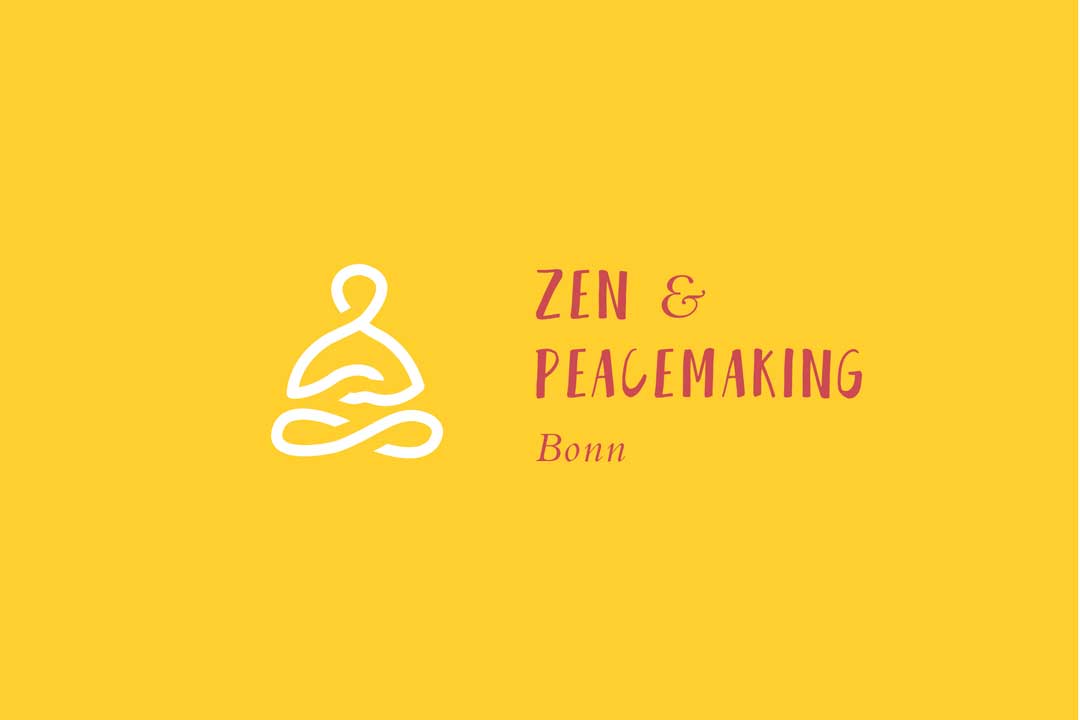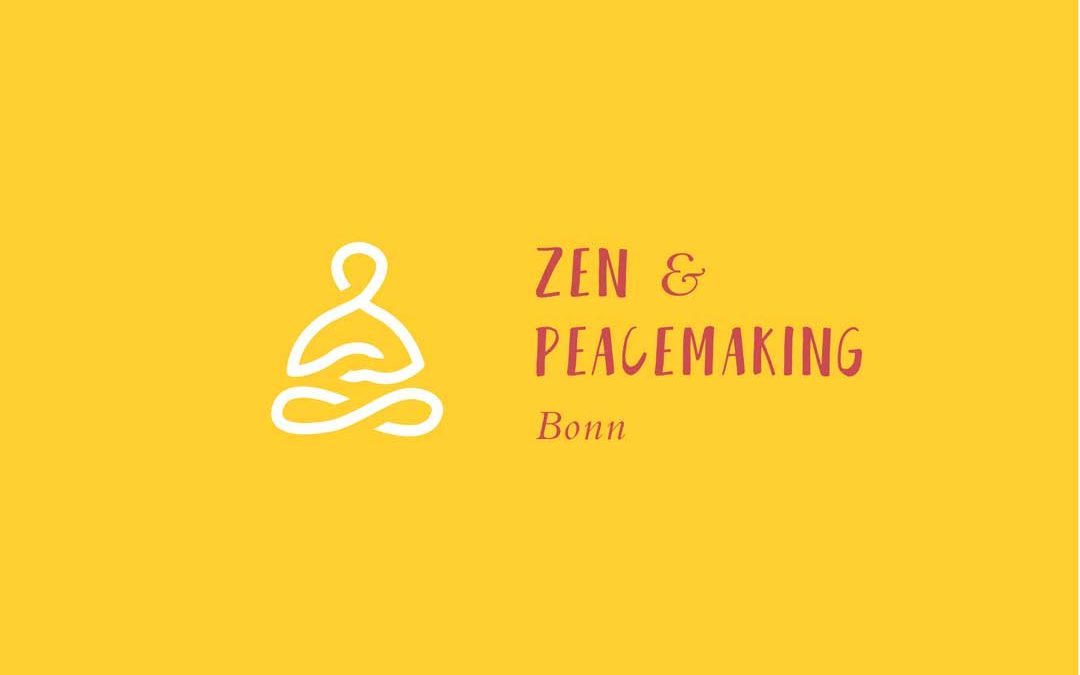Dear Seekers, Sitters, Sangha Friends,
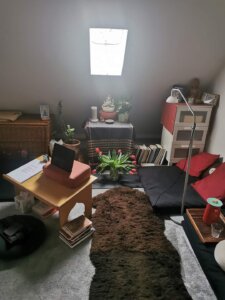
The „Tiny Temple“ in Bonn
Here is a summary of the Zen and temple offerings available until Christmas:
Current Offerings:
- Hybrid Zazen: In the summer, daily mornings from 6:30-7:30, followed by 7:00-8:00. Saturdays and Sundays: 8:00-9:00. Wednesdays and Sundays with recitations for the sick or deceased loved ones.
- Online Evening Zazen: 21:00 or 21:30, increasingly arranged in a WhatsApp group.
- Half-Day Sitting (Hybrid): On September 3rd, exceptionally from 8:00 AM to 12:00 PM, November 26, 2023, from 9:00 AM to 2:00 PM (no Zazen before). Please inquire about the program, which includes various traditional exercises, multiple Zazen and Kinhin sessions, tea and snack breaks, lectures, and heart-circle discussions (Council). Theme: The Seven Types of Meditation.
- Sitting Group Meeting: October 10, 2023, from 11:00 AM to 4:00/5:00 PM. Activities include Zazen in the Small Temple, Cappuccino Meditation, heart-circle discussions, a walk to Venusberg, early closure, review, and outlook.
- NEW! Long-term Project – Heart Circle Discussions: The Meditation of Communication/Optional Training (voluntary, meaning anyone, regardless of gender or age, can participate without training intent). Dates: September 1, November 3, December 8, 2023, January 12, January 26, February 9, 2024, each from 6:00 PM to 9:00 PM. The project will run throughout the year, approximately once a month. You are welcome, including teenagers and seniors. Individuals with special needs are kindly requested to have a preliminary discussion with me, as they may not be able to climb to the fourth floor (Temple). In that case, I will rent a room.
- Module I: Introduction to Circle Work
- Module II: Introduction to Group Dynamics
- Module III: Ruth Cohn and TZI
- Module IV: UBUNTU: The principles of Ubuntu include Respect, Care, Compassion, Love, Solidarity, Sharing and Taking, Reconciliation, and Reciprocity (South Africa).
- Module V: Shamanism: Initiation Rituals
- Module VI: The Three Principles (Tenets) of Zen Peacemakers (Bernie Glassman)
- Self-assessment: If you have easy access to wealth, please choose between €65 and €45 per module. If you have limited financial resources, please choose between €15 and €25. Thank you.
- After each module, I will write a creative summary for which I also request a fee. Please choose between €7 and €20. Thank you.
- By the way, in this community-building project, we do not turn away anyone experiencing financial difficulties but who would like to participate in the training. We clarify this in a phone conversation.
- Yearly Circle Festivals: September 21, December 21. We will definitely go outside unless it is pouring rain. Depending on the season, bring cushions, blankets, water or tea, and possibly healthy snack ingredients. Activities include walking and sitting in silence, singing, chanting. The Heart Circle will take place outdoors or in the Small Zen Temple for Zen Peacemakers. We will communicate the exact times later or you will find more information in the next Temple News.
Where will I be if I am not in the Small Temple or not giving retreats/seminars? Perhaps you would like to join me virtually or in person?
- I sit at everdayzen.org in the afternoons (4:30 PM – 5:00 PM) and on All-Day Sits (usually the last Saturday of the month) as often as possible.
- I listen to podcasts from Norman and the teachers at the Upaya Zen Center, and I recently participated in the Dogen Retreat with wonderful lectures. I always enjoy experiencing Roshi Joan with freshness and appreciation.
- I continue to enthusiastically follow James Ford through his writings and readings. If I had more time, I would join the Empty Moon Sangha, where you can sit, listen, read, and even study koans without complications or donations. Sometimes I think I should do that. James is interreligious and incredibly creative, lively, and unpretentious, loving both the Unitarians and the Zen folks.
- At the Dana Center in Montreuil, Paris (Link): I am fairly certain I will attend two sesshins: October 21-28, 2023, with Genno (Cathérine), and the end-of-year sesshin with Genko (Michèl, Link).
- Between Akazienzendo and Dharma Sangha Schwarzwald and Leerer Wolke (NEW!), I can hardly decide. I need strong guidance. Both Akazienzendo and Dharma Sangha are connected to the San Francisco Zen Center, just like me, with Dharma Sangha having stronger ties because Baker Roshi was one of Norman Fischer’s teachers. Sometimes, I think I can recognize that when I hear him, especially when I hear Nicole Baden translate so naturally and confidently. I only know that I currently enjoy sitting in a Sangha on Thursdays, writing back and forth, which is literally only half an hour or three-quarters of an hour away from me and in German.
- At a Pax Christi meeting: The next one is scheduled for August 29, 2023. There are plenty of peace days, Hiroshima days, and even „environmental days“ organized by the DBU. This DBU group recently held an impressive long walking meditation in Hannover that inspired me: „Consumer-Critical City Walk“.
- Rarely: at Via Integralis, Bonn, with Winfried Semmler Koddenbrock.
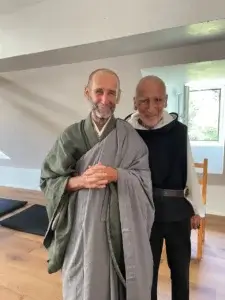
Vanja Palmers and David Steindl Rast
© www.felsentor.chIn the „Christian-Jewish Café„. 1st Thursday afternoon of the month or in the Temple Street Synagogue, which is currently under renovation.
- On the street somewhere, at the visitor service meeting in the Friedenskirchengemeinde, with the „Omas gegen Rechts“ (Grandmothers against the Right) in Cologne, or the SeaWatch meeting in the marketplace.
- Perhaps I don’t want to be found and prefer to walk around or ride my bike, with my iPad and a diary and a book, because I want to have my peace.
- Since I also appreciate the interreligious path – I basically learned it from and with Bernie – I am also drawn to Vanja Palmers and Brother David Steindl-Rast (more for longer sitting periods). The simple life they both seem to lead attracts me. I find it practical and straightforward.
As you can see, I am either crazy or enthusiastic, probably both. But I can also say „no“ and not show up for months (in the café formats or at vigils, etc.). What I try not to neglect are the Zazen/sitting meditation sessions.
„Being Human in Our Country – NO ONE WILL BE FORGOTTEN“: Pilgrimage to Terry Schwarzberg/Munich and to Dachau! WILL YOU JOIN US OR JOIN US? Rough plan: Monday, November 6 – Saturday, November 11, 2023.
Please note that I wrote this text more than a month ago.
Since then, some decisions, then still open, have been taken, for which I am really glad.
I have been an on the summer and autumn waiting list for sesshin with Vanya Palmers, in Haus Felsentor, and next year in Puregg.
All of the sudden I got a note for those on the waiting list that he and Manfred Hellriegl, whom I also wanted to get to know personally, would offer an additional sesshin in November, for those on the waiting lists.
I immediately registered. And dropped three other sesshins. I just concentrate on the few, and one item is to nourish fervently my own offers.
For those who love reading und wish to know more about me:
Long version here:
I don’t know how you are doing after four years Covid. Talking for myself, I perceive a kind of cut between a „Before“ and an „After“. By means of the diverse newsletters some of you know that my seminar-business has totally changed. But this is no issue today, and I am strongly engaged, to make a new start. But the activities around the key-words meditation, zen, certain trainings, retreats, pilgrimages, I am offering, have also changed! I used to be accustomed to, and enjoyed, the fact that people who wanted to meditate, sit, or practice with me naturally came in person to the Small Temple! I was used to always preparing this former laundry drying room first, buying fresh flowers, even for the hallway and the staircase, and simply keeping this area in order. During short breaks, we used the stairs for walking meditation (usually two flights out of four) and sometimes the garden (for 30-minute walking meditations), although we had to take a few steps to get there. I have fond memories not only of the collectively prepared cappuccino from the regular cappuccino meditation, which took place on Friday mornings, later alternating with Saturdays. Sangha breakfasts were held, in the temple or in the living room. Often, vegan delicacies were brought by the group of five medical students and one media design student, who became friends with each other and successfully endeavored to embark on their respective foreign study programs with the Humboldt Foundation at the same time: one sangha member (Pauli) in Greece, one (Sophie) in Spain, one in Portugal (Joana). We stayed in touch by trying to sit together as often as possible, at least once a month in the morning. This was not quite easy due to the different time zones, but we persevered! We took on the wonderfully stirring book „The Lost Light – Stories of Wise Women from 2500 Years,“ edited by Florence Caplow and Susan Moon, and developed our own creative method to solve this self-imposed task. This task had to do with Intuitive Writing. We typed up our own text after each session and made it available. One of us (thanks, dear Pauli!) collected these texts. Unfortunately, we have not yet found a good way to place them in a context that would be interesting and readable for others. Often, as a kind of crowning touch, I would read the response text as a voice message on WhatsApp, which is printed in the book after each story and interpreted by a Dharma teacher or priest, as I mentioned earlier. We had a very good, productive time with these meetings, as well as with the approximately half-year period during which we met on Sunday evenings for the so-called „Tatort Meditation,“ focusing on „Healing the Pain in Our Relationships.“ We used exercises from Nonviolent Communication (NVC), Metta meditation, and role-playing for this. I learned a lot.
One by one, during the Covid years, the state exams were passed, doctoral theses were written, the clinical year was completed, and the second state exam was passed. By now, everyone has done so. I am incredibly proud of all of them. For a long time, we tried to maintain a certain rhythm of practicing together despite the physical distance (one former student lived most of the time in Africa, where she volunteered; another was often in Norway with her boyfriend; the next one was in Hamburg with her boyfriend, and so on), the increasingly limited free time, and different life developments, including two family additions. Then we practiced together through the screen! We tried to sit together as often as possible, aiming for weekly but at least monthly sessions. This was not easy due to the time zone differences, but we kept at it!
I could recognize from this that what is repeatedly said and written is true: There’s nothing like a regular, consistent practice, preferably led by the initiator who holds and feels called to both partake in and willingly share this practice. I still find this fundamental idea fantastic, and I try not to be easily swayed by my own ups and downs and simply remain: simply stay with it.
In short, hardly anyone comes in person anymore. Once a year, we try to organize a personal meeting in the new small group. Verena and I sat together for a long time, working through Thich Nhat Hanh’s book „The Miracle of Mindfulness“ and practicing. Thank you, Verena, it was a good, familiar, and enlightening time. The next group meeting will take place on October 15th this year. Please find out the exact start and end times. (Probably from 11 am to 4/5 pm: Contents: Tea/Cappuccino meditation with a circle of hearts, a walk to Venus Hill, a small meal at the Waldschenke, and returning to my house). Last year, we had a wonderful summer day by the Rhine, including meditation and council (circle of hearts). Two men, Matthias and Ingo, and a woman, Katrin, sometimes also the 11-year-old Edda, meditate with me regularly. We practice Zazen, and we’ve also done guided meditation by Thay (Thich Nhat Hanh), which I have memorized. Sunday is the most popular, one hour from 8-9, and we recently added short practice discussions afterward. Sometimes it’s also on Saturday and Sunday. I meditate daily, starting 30 minutes earlier in the summer, from 6:30-7:30. Last week, there was a spontaneous request to meditate in the evening from 10:00-10:30, and I embraced the idea and invited three times in a row. Since it has become cooler, we have also been sitting one hour earlier. Please inquire if you are interested. I am happiest when I meditate in the morning and evening. Right now, I’m wondering what’s missing to maintain this practice alone and on which days. In the mornings, Ingo and Matthias sometimes sit with me. Most of the time, I recite the names of the sick or deceased people in our community by myself. However, a few evenings ago, it felt right to recite with Matthias, and I posted the „Enmei Jukku Kannon Gyo“ sutra on the WhatsApp group „Little Zen Temple“ so it can be read and learned. You can also join this group if you want to sit regularly with us. The two recitation days are Wednesday and Sunday.
We recite the „Four Great Vows“ alternately in English (everydayzen version) and German (zen peacemaker version) every week. I’m accustomed to English, but the main reason is that English is the language in which we, as „World Citizens“ (Bernie Glassman), can communicate with each other beyond nationalism. German is important so we know what we are actually reciting and can reflect on it. For example, Vera, who has her roots in Christianity but followed Thich Nhat Hanh’s teachings on „The Miracle of Mindfulness“ and the Zen form – as I practice it – with me for a while, didn’t like to sing, „The way of the Buddha is unsurpassed…,“ but rather „the path of awakening…“. I emphasize that those interested can decide where and when they want to participate in recitation, bowing, etc., by participating in detailed explanations/introductions and shared experiences. These rituals can provide guidance, harmony, and deep joy, similar to a well-led choir. And if not joy, because we are not always in a good mood every day, at least a sense of calm, quiet confidence, or at the very least a feeling of community, belonging, acceptance, self-efficacy. We should never underestimate that people long to be able to do something (beyond what is supposedly necessary to succeed in this society), to contribute something essential to the well-being of the small and large community, to be seen and heard, perhaps in a deeper way than usual.
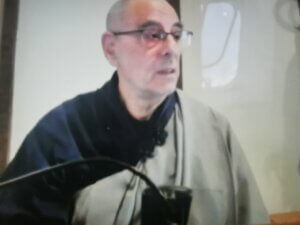
Norman Fischer
If I were to summarize the past four years of my spiritual/religious/maturity practice (which is actually impossible, maybe my main teacher Norman Fischer (during the past four years) could say something authoritative about it), it would be the four practice periods (almost 3-month intensive practice periods) that attracted, fascinated, touched, and challenged me. Three times these took place from September to the end of November, in 2023 from January to early April (there was no practice period in 2022 because this change from autumn to spring took place). On the one hand, this was very unfavorable (from the perspective of income generation, because February to Easter and Easter to summer is a very important time for offerings, especially now during the ongoing war, inflation, climate catastrophe, and the mental strain that comes with it); on the other hand, I was able to go to San Francisco in the spring of 2023 and conclude with the Sesshin of the practice period in Santa Sabina. That was wonderful.
As many of you know, the paths of Zen/contemplation/meditation/“practice in the field“ are just as significant to me as my calling as a poetry and bibliotherapy practitioner. Both callings are arts of living and fit together so well! Yes, to be able to make and maintain contact and remain open, I must actively cultivate and practice what involves silence, inner cultivation, resource care, and the renunciation of action and recognition, and this becomes more urgent as I get older. – Regarding the practice period as organized by Norman Fischer and the leadership team: We, the ones who register, always set goals at the beginning of the practice period, which we communicate to the teachers, priests, „elders,“ and at the end, we assess how we did. In addition to weekly Dharma seminars, usually on classic Zen or Buddhist texts (but not only), which I tried to participate in quite regularly despite the early morning/late-night hours (alarm clock!), and not only monthly „All-Day Sits“ on the last Saturday of each month (I rarely missed one), there were additional meetings with a „senior“ that we could usually choose, and a practice partner. Tea conversations, daily Zazen, and a 7-day Sesshin were also part of it.
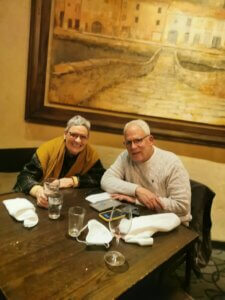
Monika and Steve Gross
In essence, I still can’t find words for the experience of the long and comfortable flight to San Francisco (it takes 10 hours). I had three seats to myself, and I slept a lot when I wasn’t looking out the window in amazement or reading. We also received two meals, and on the return flight, everything was darkened for a long time to make it feel like we had slept through a whole night and arrived in the morning. That my friend and brother Steve Gross was waiting for me at the airport and first invited me to an incredibly good Italian restaurant and then took me to the booked hotel in St. Raphael was a heartwarming gift. Steve was my first practice leader (Shuso) in 2019, and we became friends afterward, having confidential Zoom conversations from time to time.
On May 31st of this year, Steve received what is called „Lay Entrustment“, which means he is now authorized to teach the Dharma. I am very proud of him and share in his joy. I did not witness the ceremony because, since my return from the USA, I prefer not to attend evening events for the sake of my health. By evening events, I don’t mean waking up at 4 in the morning, which I could and would gladly do. It’s the times between 1 and 3 in the morning that I find very exhausting. With the right attitude, it is possible and sometimes necessary (for the sick, babies, children, and the dying, and for very important endeavors, of course!), and I want to emphasize that. However, often I was not quite myself the next day, especially on Thursdays, sometimes even longer.
These so-called Dharma seminars, which take place almost year-round, sometimes led by other priests or teachers besides Norman, were the best way for me to get to know the Sangha „everydayzen.“ Although the Dharma talks are always recorded and available to listen to, the live connection to Sangha topics that are touched upon at the beginning or end is missing. Furthermore, we see familiar faces in their spaces, the beloved altars, and so on over time, and we feel familiar. Especially at the beginning when the group was smaller, before Covid, it had been a space of protection. Later, the Sangha could become very large, spanning several „pages,“ and during „All-Day-Sits,“ you saw a whole bunch of people that Norman might only know or get to know shortly. I found this unsatisfying and disappointing for a while. It took time for me to find my place at the All-Day Sits and to feel comfortable in group dokusan with Norman. If one of the group meetings was canceled for some technical reason and individual dokusan sessions did not take place for a while, I found it increasingly unsatisfying, almost sad, to sit with the group. It hardly mattered whether I was present or not. When I look back on this, I am doubly grateful to have been in the USA: my stay, the personal meetings with some Sangha members, and the Sesshin itself helped me to strengthen the „older sense of belonging“ that had been somewhat lost. The more often the Sangha could meet in person again, the more we somehow „disconnected“ or „fell off,“ despite all the skill with which we Zoom participants were handled, which of course ALSO has to do with the drawbacks of the time difference.
In 2022, I was very frustrated that two beloved retreats, one with Dorothy Richman and the annual one in Samish Island with Nomon Tim Burnett, did NOT take place in hybrid form this time. I had participated in both formats at least twice; they were nourishing and deep and structured my year. I wasn’t ready to look for a „replacement“ in Europe, especially since Covid was not completely over yet. It should be noted that these years on the screen, where EVERYONE was on the screen, were a result of the pandemic. I would probably have come across Norman in this way, but it is unrealistic to assume that I would have been so closely connected to two American Sanghas without the necessity. The technical quality of the transmissions was excellent and fast compared to many other European ones. Two other arguments also played a role: I spoke, speak, hear, and read English increasingly well. AND: Both Sangha leaders, Roshi Joan and Roshi Norman, write a lot and communicate well with other prolific writers. Joan does more on Facebook, Norman writes more books. This was and is a big plus for me.
The report would not feel complete if I did not also address the weeks before my departure to San Francisco. There was a surprising and positive turn when Norman Fischer got involved in the question of where to find accommodation in the days before the Sesshin. Suddenly, something became possible that I had not seen before. One can live, practice, and work as a „resident“ in Green Gulch for a minimum of 14 days, in my case, 8 days, at a low cost, just like everyone else. You should know that Green Gulch is absolutely enchanting, far from the noise, surrounded by fields and cultivated beds, tall trees, and right on a charming trail to Muir Beach, where Norman also lives and often, as I later found out, gives dokusans. It probably happened often that Europeans lived there briefly or for a long time and met with someone for a conversation. Today I look at it all calmly because I was there and spoke with many people. In short, it seemed to be THE SOLUTION. I would arrive one day before Day 1 of 8 days, have one night in a hotel (which I quickly booked because I already had the flight ticket), and then live in the retreat house from Saturday to Saturday, where Mary Ann would pick me up in Santa Rosa. Everyone who helped me before, thought together with me, promised to visit me in Green Gulch, and there were quite a few: Jane Flint, Susan Moon, Mary Ann Sacksteder, Anlor Davin…provided me with information. Also, the young guest coordinator in Green Gulch sent me the endlessly long form that is intended for applicants applying for two years as well as for people like me. You practically have to list every illness, every medication, all doctors, emergency contacts, all prior knowledge, aspirations… and all of this was not only a lot of work for me but also for this Sangha sister responsible for guest coordination.
It seemed like everything was ready, but then, the ESTA form from the Foreign Office, absolutely necessary to board the flight, did not arrive. Despite various urgent requests, phone calls… it did not arrive in time, and I had to cancel the flight, the stay in Green Gulch, everything, including Santa Sabina. Until after a night, I was clear that I would not give up but would fly when I had the ESTA form in my hands. As you all know, since I did fly, it seemed to have arrived. Yes, there are also fraudulent offers in this area. My first one was too expensive and yielded no results. The next one was affordable, and I had ESTA in my computer within half a day. Everything was embarrassing, uncomfortable for others. And expensive. I received a 70% refund of the flight costs; the new flight was more expensive, and the hotel and ESTA were not refunded. I was almost not interested anymore. I did not want to start again in the fall with the question: Mexico: Yes or No? Although I would probably have been better off in Mar de Jade. I felt the need to experience the most classic of all Sesshins and see as many of the other beloved Sangha members in person as possible: Jaune Evans, Susan Moon, Jane Flint, Christopher Dumbleton, Shuso Neal Shorstein, Mary Koopman, Shuffy, ah! Shuffy, and many others whose names I can’t recall right now but who are very familiar to me. So: Everything is practice. Bring on the Dharma Gate! The Dharma Gate: Embarrassment. Fear. Rejection. Or the fear of it. Failing. Yes. Always, really.
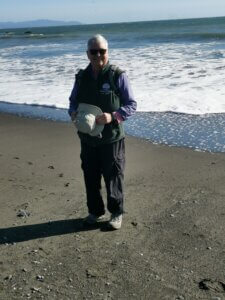
Mary Ann Sacksteder
I was also very happy that Girija Brilliant took care of me and left messages at the hotel. The shared Asian meal with her husband Larry Brilliant, who, to my delight and surprise, allowed me to briefly speak with his friend KD (Krishna Dass), the subsequent drive under the Golden Gate Bridge, with stops and photos… and the walk with Girija from her dream house down the hill to the river… all of this is etched in my memory and heart. We then met on the Saturday when one of the tea talks also took place in a privately located house somewhere beautiful: Mary Ann Sacksteder then picked me up and drove me to Santa Rosa. The generous and early invitation to spend two days as a guest at the Santa Rosa Community Project deeply touched me, and knowing about it months before the trip helped me overcome many fears and feelings of loneliness.
But before that, I want to tell you how warm-hearted the hotel staff were, how well I slept there, and that on the first day, Anlor Davin and Patricia Sullivan picked me up to take a wonderful walk with me in windy, sunny March weather. The three of us were so glad to be able to talk and laugh together under pleasant circumstances. The farewell was only partial because Anlor would also personally attend the Sesshin. It was cheerful and beautiful hours with both of them.
I don’t remember when I spent the morning alone in St. Raphael: first walking along the busy road for a long time, which I didn’t mind at all because I found the road signs with familiar names on them, the sun, and the landscape very interesting. For a few hundred meters, I then took the bus, which had mostly Spanish-speaking people on board. I found this very interesting because I also heard and spoke Spanish at the hotel: were the employees here „Mexicanos“? Just as in some neighborhoods where almost only Turkish, Italian, and Spanish people live and work, is it the same here with „Latinos?“ I strongly welcome the fact that I studied Romance languages and am appalled by how racist and unfair white people are and still consider themselves civilized! Of course, I include myself fully in this! It’s a perceptual disorder based on narcissistic delusions, not on knowledge, solidarity, and mutual recognition. I don’t mean to say that what I see and say is absolutely right. But I want to be able to be open without fearing being ostracized.
The initiatives I encountered on my stroll through St. Raphael appealed to me: from food sharing to services for the elderly to a vegan café/restaurant, there was a variety. Environmental measures were also taken, and there was a list of event dates that impressed me. I hope that Buddhist friends will cooperate with grassroots cooperatives and the like.
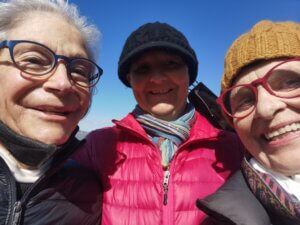
left Patricia, right Anlor Davin
As you know, my goal this spring was to experience the Sesshin in person at a former monastery (Santa Sabina) on the outskirts of San Francisco and spend a few extra days (originally a week was planned) for practice (unfortunately, Green Gulch didn’t work out, even though they were very accommodating, including financially). But even so, it was beautiful and nourishing – although at times, it was way too expensive, like the hotel at the beginning of my stay – to turn familiar faces and some conversations on the screen into living people and relationships! I was invited to experience a wonderful concert evening with Zen priestess and friend Mary Ann Sacksteder and her partner, and I got to choose which region I wanted to see or explore a bit the next day. Mary Ann promised to take me where I wanted to go. In heavenly sunny weather, we took a tour to Green Gulch; I really wanted to see this Zen farm again, walk the path to the Pacific, and sit on the sands of Muir Beach before I, as I believed, would return, experience the Sesshin, and never come back. This clear, joyfully melancholic feeling has persisted.
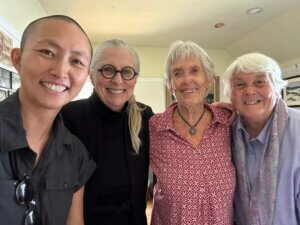
Recently, Joana Macy, our favorite elder, was at Upaya Zen Center, Santa Fe. On the far left is Dr. Wendy Lau, and on the far right is Wendy Johnson. All four have grown on me.
After thirteen years of increasingly intensive work with American Zen teachers – and here, I would like to particularly mention Zen priest Joan Halifax – with whom I spent many weekends, zazenkais, and practice periods (often in January and April), listened to countless podcasts featuring her numerous highly interesting collaborators. I am very grateful to Roshi Joan and our European sangha leader Irene Bakker for the SEBT=Socially Engaged Buddhist Training program from January 2021 to January 2022. What a stimulating time! After years at the Rinzai Zen temple „Choboji“ and with Abbot Genjo Marinello in Seattle, building a Rinzai Zen sangha in Bonn, a few self-organized Sesshins, and a series of moving and emotionally charged bearing witness retreats with Bernie Glassman and Eve Marko (Auschwitz, Black Hills), it seemed that my time with American teachers was coming to a certain end (however one defines it). Also, for the important reason that neither Norman Fischer nor Joan Halifax would continue to teach in Europe.
Training with Joan taught me, among other things, to actively seek collaborations. I have done this in various areas and am delighted to engage in interfaith activities. My teamwork with Jewish siblings has intensified through outings (tomorrow I am going to Siegburg again) and a pilgrimage to Munich to visit the wonderful Terry Swartzberg. In the Evangelical Peace Church community near my home, with the creative and compassionate pastor Stefanie Graner, I am involved in visitation services and am ready to step in here and there. I see a writing course in the community, ending with a full writing day on Saturday, as another hopefully interesting contribution on my part.
I finally managed to attend the last „Pax Christi meeting„. It was good for me to engage in deep discussions on topics related to peace, especially regarding wars, weapons (especially heavy and nuclear weapons), and escalations. I found myself mostly on common ground with those who are critical or entirely opposed to these issues, which I hold critically as well.
I am currently in friendly negotiations with the Catholic Educational Center to offer a series of courses. I hope to be able to provide more details soon. Since the theme will revolve around „life transitions“, the offering will be available in both the writing school and Zen areas, meaning HERE. Jürgen König will boldly post the proposed dates on the website.
Currently, I declare the last week of each month as an „intensive practice week“. Anyone interested in planning and sitting with me is warmly welcome. It works as it goes, and this small, cost-effective solution makes me extremely happy.
Zen teacher Nicole Baden, who leads the Dharma Sangha Center in the Black Forest, has also caught my attention. I have listened with great benefit to some series of her talks (although I could only participate minimally in the fall practice period due to my busy seminar schedule) as well as series of talks by her teacher, Richard Baker, which Nicole usually translates. Spending some time there, is it something for me? I wondered. Richard Baker is also one of Norman Fischer’s teachers, and so I found a particular interest in hearing about Suzuki Roshi’s famous book, „Zen Mind, Beginner’s Mind“.
I also felt comfortable at the Akazienzendo Berlin, with Bernd Bender. In early December 2022, I learned very suddenly that David Loy would be holding a workshop there. I had the day off, so I went, and I have no regrets. Shouldn’t Buddhists all strive to learn and become „Eco-Sattvas,“ meaning to naturally include the Earth and its creatures in our prayers, good wishes, vows, and practice journey? Shouldn’t we begin to read the sutras and Buddha’s teachings with a historical-critical perspective, as I learned to do with literature and later with the Bible at university? To read them through the various lenses of enlightenment, feminism, psychotherapy and psychoanalysis, progressive critiques of authority and colonialism, and criticism of capitalism? How can Buddhism, like it did for Dr. Ambedkar, the great Indian scholar and founder of the Indian constitution, who fought for true equality and the abolition of exploitation and the violence of poverty, also for climate justice, be reinterpreted and lived anew, credibly? How can the tremendous emancipatory power of Mahayana Buddhism be conveyed and lived in a way that touches more people’s hearts and becomes effective?
Furthermore, I also find it important – and this is due to Bernie Glassman’s teaching and practice – to look beyond the boundaries, beyond the horizons of our own religion, our peer group, our nation, and our class. But also, and this is the shockingly new part, beyond the boundaries of our own Buddhist comfort zone. Bernie cannot be accused of superficiality, indecisiveness, or arbitrariness, which is why his vision is so unprecedented. He believes it is important to train and become knowledgeable in a spiritual direction, but he doesn’t believe it has to be Zen! And even if it is Zen, he wishes that his friends and students are truly open to other Buddhist traditions and learn from them. This was and is new to me, and I experience this freedom like fresh water. When I hear myself speak like this, I think that this unusual person, teacher, friend, perhaps, is my true teacher (or has been), along with the place Auschwitz – meant in the broadest sense – which Bernie called his real teacher. When I asked Bernie about it, he replied that he no longer had personal students. There are plenty of other talented teachers I could ask.
I want to dedicate a separate text to this teacher, my Zen Peacemaker grandfather, as I often like to say.
Looking back on the COVID era from the temple’s perspective and a bit before it: a time that has been scarcely documented or documented too little. With this letter, we are trying to catch up on some of it and share it with those interested.
2018-2023:
- 2018 Retreat in Holland with Roshi Joan, Upaya Zen Center
- January 2019: Bearing Witness Pilgrimage in Sicily/Calabria: Where do all the dead go? Visiting the International Cemetery in Tarsia
- 2019 Mindfulness Teacher Training with Christopher Titmuss (5 days). I dropped out after that and joined Norman Fischer.
- 2021-2022 SEBT (Socially Engaged Buddhism) at the Upaya Zen Center. Certified by Roshi Joan Halifax
- Until 2019 and afterward, occasional practice periods (January, April, zazenkais, Dharma seminars, podcasts) at the Upaya Center
- From May 2019, intensive involvement in the everydayzen sangha until April 2023.
- November 2019 VI. Auschwitz Bearing Witness Retreat with Barbara Salaam Roshi
- 2016-2021 The Little Temple in Bonn experienced a period of growth with six students: Regular morning zazen, Fridays or Saturdays, 7-10:30 zazen; Cappuccino meditation, systematic work in the council circle, intuitive writing based on „Case Stories“ from the book „Hidden Lamp: Stories from Twenty-Five Centuries of Awakened Women,“ edited by Florence Caplow and Susan Moon; Sunday evening, 20:30-21:00 sitting, „Crime Scene Meditation – Healing the Pain in Our Relationships,“ with exercises from Nonviolent Communication (NVC), role-playing, Metta healing phrases for ourselves and others; Sangha breakfast with zazen, reflection, evaluation, and outlook.
- Zen Day: Twice
- „Being Human in Our City/Our Country“:
- Pilgrimage day to the Beuel cemetery with the graves of important Sinti and Roma dignitaries
- August 26, 2022: The death of my mother, Christiane Weissmann, nee Strunk, *March 4, 1929, in Landsberg/Warthe (now Polish Vitnica)
- 2023 March 24 – April 2: Trip to San Francisco
- Participation in demonstrations by Sea-Watch, Easter March for Peace, sit-in in front of the Bonn Synagogue.
- Council training with Luis for and with Abdullah, Mehmet (documented)
- Regular contact (video calls) with a Syrian-Kurdish family in Kiel
- Excursion with the
- Excursion with the „Christian-Jewish Society for Cooperation Bonn“ to Ahrweiler
DEEPLY FELT GRATITUDE for your donations, whether in the past years or now. Without your generosity, I would have had to limit or stop my own generosity. Even now, due to inflation, it is very challenging to pay my bills on time.
I would be VERY HAPPY if you, or you, could support not only the volunteer activities but also the events such as pilgrimages, participation in Zen Sesshins (trainings!), fees for numerous teaching materials like books, lectures, travel expenses, and, not least, the shared rent and energy costs for the Little Zen Temple with a generous donation or several small ones. As I increasingly write and wish to write, my time for earning money is also limited. From Bernie, I learned to speak openly about financial matters, just as we do about our spiritual concerns and motivations.
Bank details: Sparkasse Köln/Bonn, IBAN: DE55 3705 0198 0032 9013 40
PayPal: m.winkelmann-schreiben@web.de
From our esteemed teacher Thich Nhat Hanh comes this word:
„I am here for you now, my pain, and I will take good care of you.“
With inspiring greetings! May we also touch the pain of other beings in a healing way!
Yours,
Monika
